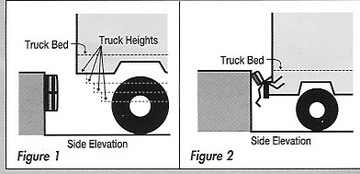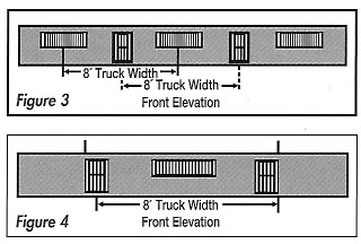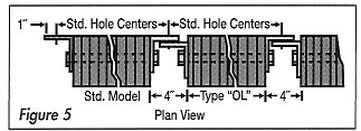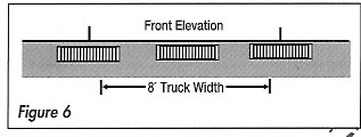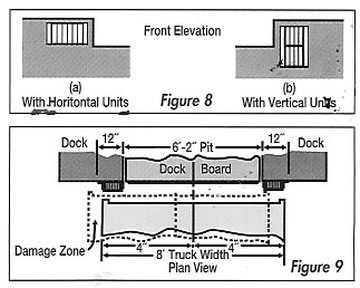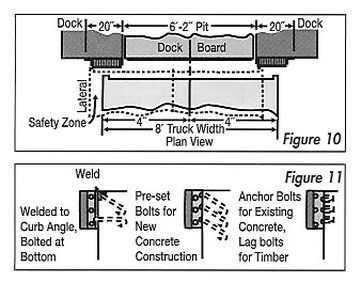Dock Bumper Protection
Application Guide
|
Bumper Heights
Our standard dock bumper heights are 6", 10", or 12". The height can be increased by expanding the angle length and "stacking" dock bumper pads between them to create vertical units--20", 24" and 36". The primary application for the 6" dock bumper is on lip docks where the dock slab projects beyond the foundation with an impact face of less than 10" high. The 10" dock bumper is widely used for standard height docks that accommodate standard, or approximately equal-height trucks. The heavier constructed 12" dock bumper provides greater area and cube of rubber with a stronger steel frame (three connecting rods.) The 20", 24", or 36" vertical heights provide extended depth protection for varying truck heights. (Fig. 1) or the lower steel members of trailer bodies. Consider them for docks that accommodate panel and pebble trucks as well as over the road trailers. Vertical units are particularly applicable with truck leveling devices that raise the entire truck to dock level. Combined with horizontal units, (Figs. 3 & 4), vertical units prevent a loaded trailer from prying off the shorter bumpers as the truck bed rises while being unloaded (Fig. 2) For Open Docks For open docks with no predetermined truck spots, combination installations provide maximum protection (Fig. 3) If 36" horizontal length dock bumpers are used, maximum spacing should be 24" between units--5" on centers. (Fig 6) (For an angled truck approach, spacing should be reduced to prevent a truck corner from contacting the dock between units.) If continuous bumper protection is needed, overlapping installations on common anchor bolts are recommended and reduce anchor bolt costs by 50% (Fig 5). Overlapping reduces the spacing between each bumper to 4", and is applicable to any laminated bumper model. Overlapping angles on adjacent bumpers cuts installation costs and increases the protected area. To order specify standard model for first bumper at left, and "OL" construction on successive bumpers. Special-length bumpers to fill out dock spaces are also available. For open docks or wide bays, extra-length, one-piece dock bumpers can also be used for maximum coverage and appearance (Fig. 7) For 8', 9' or 10' Bays For 8', 9', or 10' bays a variety of combinations exist. We recommend a combination of standard and vertical bumper designs. (Fig 3 & 4) for dock protection. For Refrigerated Doors (with or without dock shelters) Refrigerated doors require 4 1/2" or 6" thick, extra-length, one-piece bumpers to completely seal the truck to the dock or shelter. The same applies to doors sealed to maintain warm temperatures. With shelters, the rubber surface of the bumper must extend under the vertical members of the shelter pad to complete the all around seal (Fig 7) For Portable Dock Plates A 36" dock bumper mounted in the center of the dock will automatically allow for dock plate insertion, even if a truck is spotted against the bumpers of the dock. With 3" angles on all bumpers, a 6" space is provided between units for the legs of the dock plate. Continue to fill the width of the bay with standard or vertical dock bumpers as needed. For Adjustable Dock Boards If using 14" lengths, height should be minimum 12", (Figs 8a, 8b). Most dock boards handle 4 1/2" or 6" thick bumpers and will not impair lip penetration into the truck. If using horizontal bumpers, use similar to 24" units but with steel plate replacing the inboard angle. Fig 9 shows damage from "short spacing". Fig 10 shows "lateral safety zone" impact absorption advantage provided by longer bumpers. Bumper Installation Install bumpers (Fig 11) 1" to 2" below dock level. Use 3/4" or 5/8" lag bolts or sleeve anchors; minimum length 3" and use corresponding shield if required. Use 3/4" "J" bolts with a minimum length of 8" with 1 1/4" projection. |
